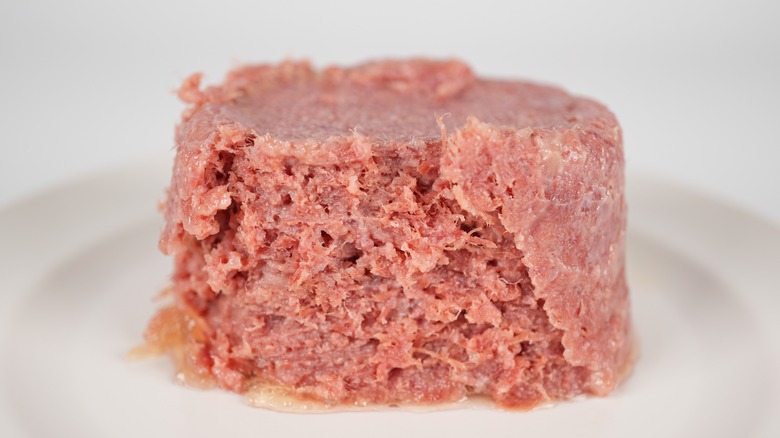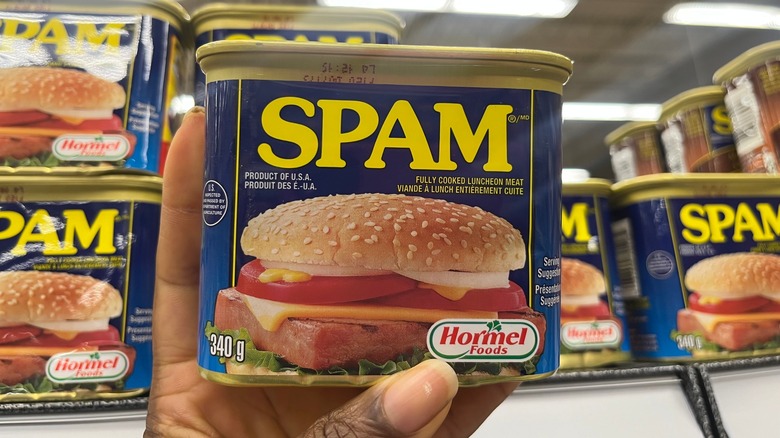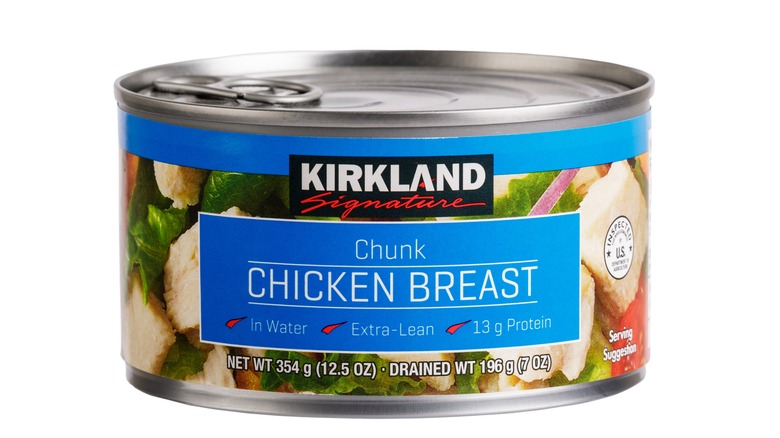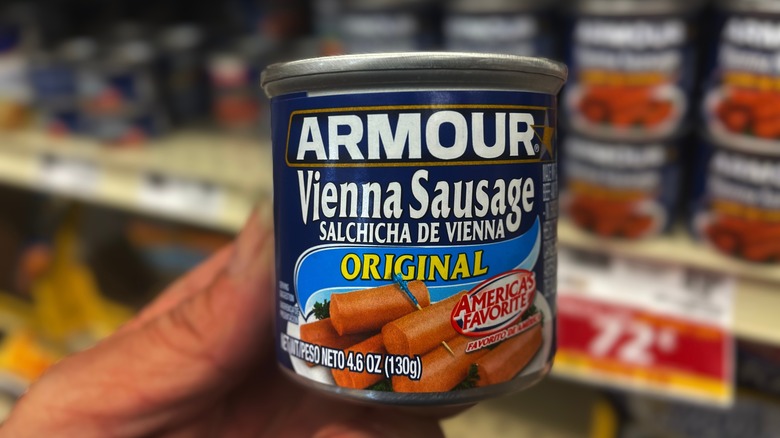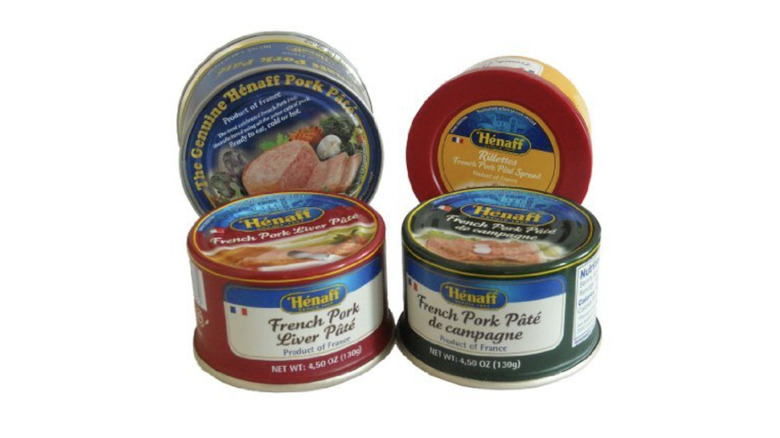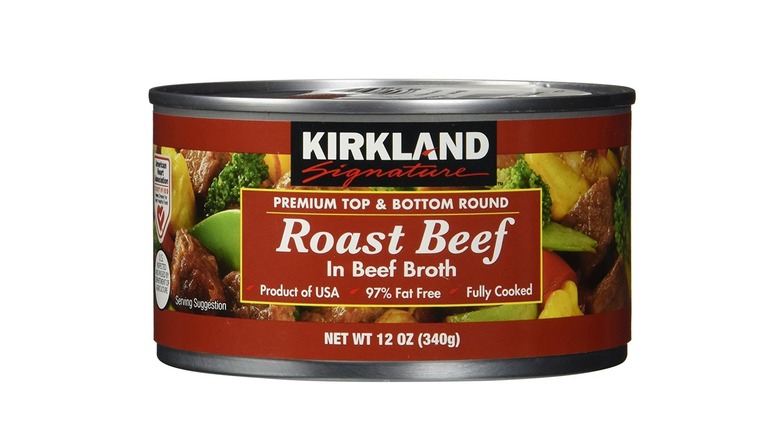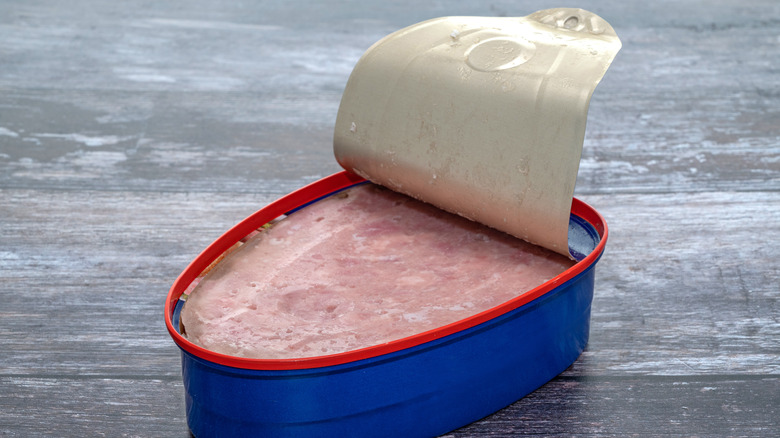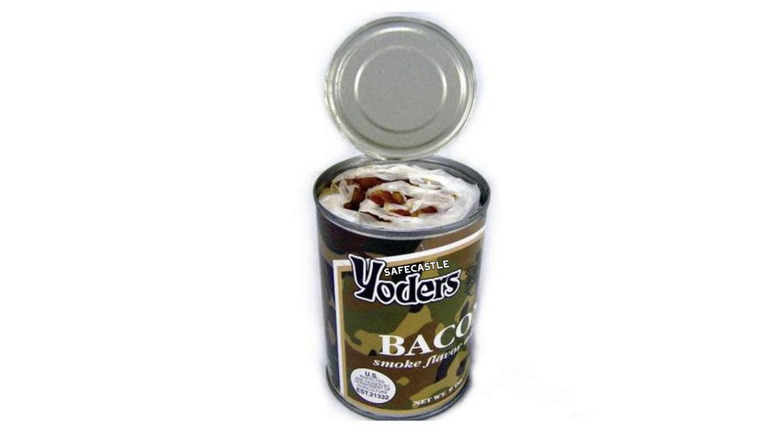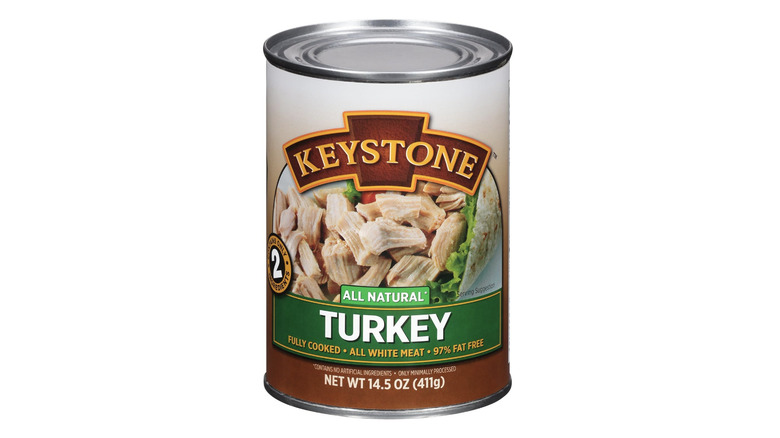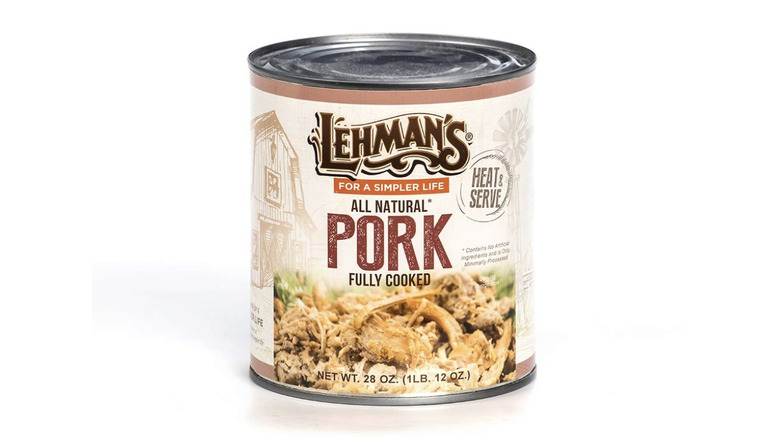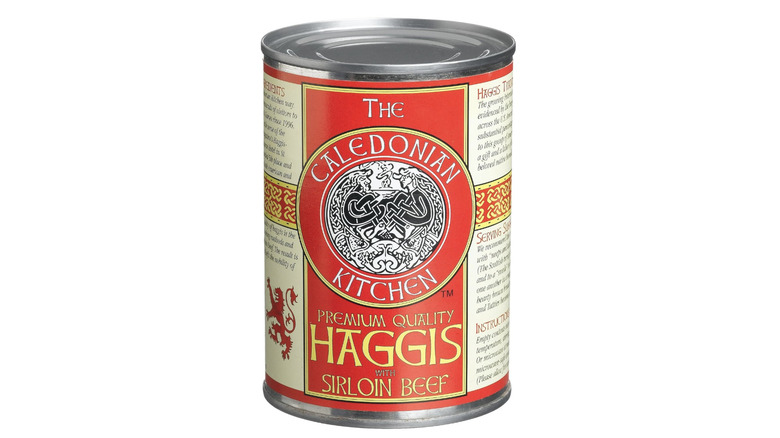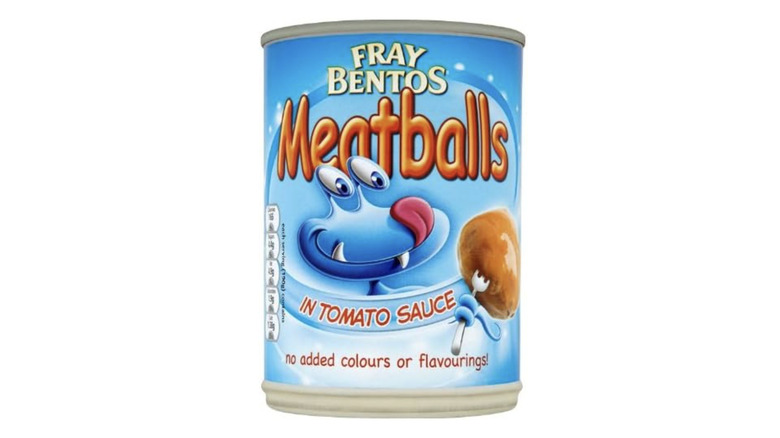12 Canned Meats That Make The Best Breakfast
We may receive a commission on purchases made from links.
It's difficult to imagine a time without canned food. The convenience of tins has revolutionized the way we eat, with many diners no longer reliant on fresh produce or meat thanks to the technology. Instead, we can easily stock up on canned goods that have been preserved at their peak of freshness. Best of all, these products come with a long shelf life, lasting for up to five years if stored in a cool and dry place such as the kitchen pantry.
Things haven't always been as easy. While we have preserved food through salting, drying, and fermentation since time immemorial, canning is a more recent invention. In 1810, French confectioner Nicolas Appert discovered that heating food in glass jars could keep it fresh for longer periods of time. Within a matter of months, King George III granted a patent to British merchant Peter Durand to package food in lighter and more durable tin-plated iron cans. Yet it wasn't until 1825 that canned fruits, vegetables, and meats made their way to the U.S. It took even longer — until the 1850s — for canned food to become popular with Americans.
While we often use canned meats in lunches and dinners, the pantry staple can also make a delicious addition to quick — or more leisurely — breakfasts. Fully-cooked and packaged in easy-to-open cans, the meats require as little or as much preparation as your morning schedule allows. They are also very affordable and easy to find on supermarket shelves.
Canned corned beef
While some believe that corned beef gets its name from the corn-fed cattle used in its production or even corn kernels, the real story is much more interesting. The term corned beef actually references the large grains or "corns" of salt that were once used to preserve it.
Usually associated with the Irish in its standard, un-canned form, tinned corned beef didn't become popular until World War I when it was rationed to British and allied troops. Usually made from beef brisket, canned corned beef is cured with ingredients such as salt, sugar, and sodium nitrite, a preservative that gives the beef its distinct pink color.
Perhaps the most famous corned beef dish, corned beef hash, makes a hearty breakfast staple. This classic meal combines corned beef with potatoes, white onion, baked beans, and a range of spices, which are fried together until nice and crispy. The dish is often topped with a fried egg. Canned corned beef makes a great addition to Reuben sandwiches. The beefy ingredient blends beautifully with the sandwich's other ingredients, which typically include sauerkraut, cheese, and Thousand Island or Russian dressing. Canned corned beef can also be mixed in with eggs for an innovative twist on a classic omelet.
Spam
Many people have a love-hate relationship with the canned meat product known as Spam. On one hand, Spam has been praised for its unique flavor. On the other, it has been criticized for its high sodium, calorie, and fat content. Whatever we think about Spam, one thing is certain — the processed meat is incredibly popular. Launched in 1937 by Hormel Foods amid the shortages of the Great Depression, today the company lays claim to 11 different types of Spam that are sold in 50 countries. In addition, Hormel says that, across the world, approximately 13 cans of Spam are eaten each second.
While many think of Spam as a versatile mystery meat, the product's list of ingredients is surprisingly simple and contains a mixture of ground pork and ham, salt, sugar, potato starch, water, and sodium nitrite (the last of which acts as a preservative).
The canned meat makes a great addition to breakfast dishes. This shouldn't come as a surprise since Spam pairs incredibly well with cheese, so try the meat in a breakfast sandwich with egg and a slice of cheese. Alternatively, pop strips of Spam into your breakfast burrito along with bell peppers, onion, cheese, eggs, and tater tots. Those wishing to get really creative can even grill Spam slices in a waffle iron for a crispy bacon replacement.
Canned chicken breast
While adding chicken to breakfast dishes may not be as popular as eating it for lunch or dinner, incorporating the poultry into your first meal of the day is a great way to stay satiated throughout the morning (hello protein!). Since it's pre-cooked, canned chicken is ready-to-eat straight out of the tin, which means less time in the kitchen in the mornings. It also means that you don't need to worry about dealing with raw chicken, which can be a potential source of contamination if not handled with care.
Canned in either broth or water, canned chicken breast is ultra versatile and can be added to most dishes you normally eat in the morning. If you're in a rush, you can even eat the poultry straight out the can — not that we recommend doing this on an everyday basis. After all there's nothing quite like a balanced diet of meat, veggies, fruits, dairy, and grains to keep both your body and mind in a tip-top shape.
For a filling and easy-to-make feast, as well as an extra burst of flavor, add chunks of canned chicken to your morning eggs. Another great way to enjoy canned chicken in the morning is to incorporate it in your sandwiches and wraps. One Quora member explains that they use canned chicken on sandwiches the same way as they would canned tuna, adding, "Mix chicken with chopped celery, onion, herbs and seasoning to taste, [add] mayo and slap it on some bread."
Vienna sausages
Did you know that in Vienna, the capital of Austria, Vienna sausages are known as Frankfurters? This is attributed to the fact that the sausages were created by a butcher from Frankfurt, Germany, who later settled in Vienna. While "Vienna sausages" can look different depending on the country, in North America the term usually refers to short canned sausages made from a blend of chicken, beef, pork, and turkey. Coming on the scene in 1903, the American take on Vienna sausages are normally smoked and preserved in cans with gelatin or broth.
The pre-cooked wieners can be eaten right out of the can. However, while there's nothing simpler than opening a can on your way out in the morning, we recommend getting up a little earlier and at least warming up the mini sausages. Even better, why not follow the advice of one Reddit user who says that they "chop them up and throw them in baked beans so it's like beanie weenies. Also chopped up in an omelet — like a less-zesty spam." Another Vienna sausage enthusiast and Redditor suggests: "Cut them lengthwise, put some gouda or other cheese in between, and wrap [them] with bacon. Sear in a pan."
Canned pâté
Translating to "paste" in French, pâté can be made from a variety of meats, ranging from pork to poultry. While the most expensive type of the spread is foie gras that's made from duck or goose liver, there are other versions of pâté out there that will only set you back a handful of dollars. These can be made from pork, beef, ham, and even game meat. When it comes to pâté, other ingredients such as vegetables, dried fruit, nuts, and spices are also often thrown into the mix for flavor and texture. Pâté comes in a variety of consistencies, including chunky, coarse, and smooth.
Since pâté comes in the form of a spreadable paste, it can be a delicious and convenient ingredient to pop on your breakfast sandwich. Simply grab a fresh baguette or some toasted bread slices, smear them with butter, and top with pâté, radishes, cornichons, and a little salt and pepper. Those who like to think outside the box may want to try adding a little pâté to their morning scrambled eggs for an extra hit of flavor and protein. Canned pâté can also be used to garnish other classic breakfast dishes such as eggs Benedict or deviled eggs.
Canned roast beef
Normally roast beef takes hours of preparation in the oven, where it's typically cooked at different temperatures to achieve a crispy exterior and a tender and juicy interior. Luckily, canned roast beef offers a much faster alternative. Unlike canned corned beef, which is usually made from brisket, canned roast beef more often comes from the round, chuck, or loin. And while most tinned versions of the meat can't replicate the texture and flavor of the real thing, customers argue that some cans of roast beef come very close.
While canned corned beef shines in dishes such as shepherd's pie, tacos, quesadillas, and beef stroganoff, the versatile ingredient can also brighten up your breakfast. As one Redditor points out: "[You can] use it in whatever you would use shredded beef. Quesadillas, sandwiches, tacos, mixed in rice or scrambled eggs." It can also play well with the other ingredients in a hash or breakfast burrito.
Canned ham
Unlike its cousin Spam, which is made from ground pork and ham, canned ham contains precisely what its name implies — pre-cooked boneless ham. In addition, unlike Spam, which comes in rectangular tins, ham is usually packaged in pear-shaped cans. Also, while Spam is ground before packaging, canned ham is made up of one or more pieces of compressed ham. During the packaging process, the meat is typically sprinkled with dry gelatin, which then mixes with the ham juices and turns into jelly that cushions the product during handling.
The savory flavor of canned ham can take your morning meals to the next level. From the humble ham and cheese sandwich to ham omelets and scrambled eggs, the meat is a firm breakfast favorite. For those who enjoy experimenting, tinned ham can also be incorporated into more out-of-the-box breakfast dishes. One of these is the bacon sausage ham breakfast skillet based on a recipe developed by Jamie Monkkonen. "This breakfast skillet reminds me of a meat lover's pizza, but the breakfast version! It's incredible how many flavors are in a single bite," he explained to Mashed.
Canned bacon
While canned bacon may not be as crispy as rashers straight off a frying pan, it does seem to retain some of the flavor and texture of the real thing. Nevertheless, canned bacon might be best suited to emergency scenarios where fresh bacon isn't available. One thing to remember is that canned bacon is generally layered with parchment paper to keep the individual slices from sticking together. This can admittedly make the bacon strips unsightly and somewhat difficult to remove from the can. Despite this, the rashers can be used in pretty much any recipe that calls for standard bacon.
Bacon is a breakfast staple for most carnivores. Savory and salty, the meaty strips of goodness can be added to a huge range of day-starters. Be it fried, scrambled, or poached, the crispiness of bacon makes a great addition to the creamy richness of eggs. A great example is bacon and eggs, a classic dish that most of us have probably tried at least once in our lives. Tinned bacon can also elevate other breakfast classics such as quiches, pancakes, waffles, and even cheesy breakfast pizza.
Canned turkey
Ready to eat straight out of the tin, canned turkey contains pre-cooked chunks of poultry that are submerged in water or broth. The turkey is sometimes seasoned for additional flavor. While some canned turkey is made with white meat, other canned products contain a mixture of white and dark turkey. White turkey meat comes from the bird's breast and wings, whereas dark meat is sourced from its legs and thighs. While dark turkey meat is usually flavorful and juicy, its white counterpart tends to contain less fat and is usually more bland in flavor.
Although we often associate turkey roasts with Thanksgiving, failing to use the poultry in your daily recipes could be a serious oversight. As far as breakfast goes, canned turkey can make a satisfying addition to egg dishes. For instance, to make a turkey filling for your omelet, simply fry the poultry with your choice of ingredients like mushroom, shallots, and fresh herbs. Turkey also makes the perfect base for a breakfast sandwich. For something a little different, why not try making a turkey Reuben sandwich to start your day?
Canned pork
While it is processed, canned pork is usually made with very few additional ingredients, making it quite similar to freshly cooked pork. In many cases, the only thing that's thrown into the mix is a little salt. Water isn't usually added to the cans before they are sealed. This may be a little unexpected since canned pork is usually submerged in liquid when the tin is first opened. Rest assured, this liquid is normally just meat juices, not any added water or broth. To get the most out of canned pork, let it sit and re-absorb the juices before use.
While canned pork isn't as popular in the U.S. as canned ham or even canned chicken, the product makes a great substitute for freshly cooked pork. An easy way to incorporate tinned pork in your breakfast is to shred it into sandwich filling. For instance, try making a canned pork Cuban sandwich with sliced ham, salami, Swiss cheese, pickles, and mustard and mayo, or add it to a breakfast sandwich including eggs and an English muffin.
Canned haggis
While haggis isn't widely consumed in the U.S. and may indeed be an acquired taste for some diners, we believe that there must be a good reason why the dish is such a hit in Scotland. If you're eager to try the Scottish pudding, investing in canned haggis might be your best bet if you're stateside. In fact, fresh haggis can be close to impossible to find in America. The good news is that tinned haggis is pretty close to the real deal, with one Reddit user going so far as to claim that it's "the only tinned meat product that actually tastes as good as fresh."
For those not in the know, haggis is made from the heart, liver, and lungs of sheep mixed with other ingredients such as beef or mutton suet, onion, oatmeal, and spices. The ingredients are stuffed into sheep's stomach lining and boiled. Haggis has a rich and peppery flavor and the texture of a crumbly sausage.
In its home country, haggis is often served with mashed potatoes or mashed turnips, but it can also make an interesting addition to morning meals. Perhaps the best way to sample haggis as a breakfast option is to fry it in a skillet. Alternatively, you can also spread the meat on parchment paper and cook it in the oven at 350 degrees Fahrenheit for approximately 20 minutes. Once cooked, spread a little of the meat on a slice of toast and top it with melted cheese.
Canned meatballs
While meatballs may not be your typical breakfast staple, they can provide a hearty and satisfying start to the day. You can make your own meatballs, but stocking up on the canned version of the protein is much less labor intensive. Made from different meat types including chicken, pork, and beef, and seasoned with a range of spices, canned meatballs typically come submerged in some type of sauce, such as tomato sauce, barbecue sauce, or good old-fashioned gravy.
While spaghetti and meatballs is a classic dish, it's by no means the only way to enjoy them — especially in the mornings. Just like other canned meats, tinned meatballs are delicious in sandwiches. One Reddit member suggests: "Strain the meatballs and make a meatball sandwich with marinara sauce and Parmesan or mozzarella." And why not enjoy a breakfast meatball sandwich on occasion? Another Reddit user recommends first tossing "the meatballs in a skillet for a couple minutes to get a nice crispy outer layer." Meatballs can also be added to breakfast fry-ups with ingredients like potatoes, eggs, cheese, peppers, and onions.

